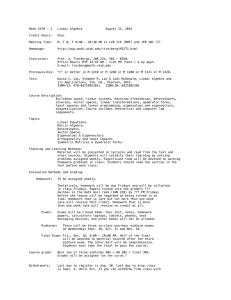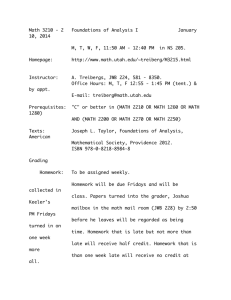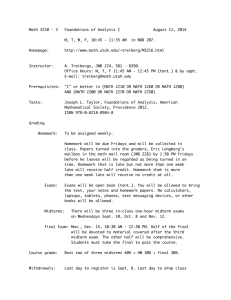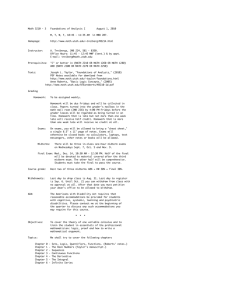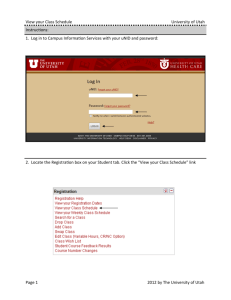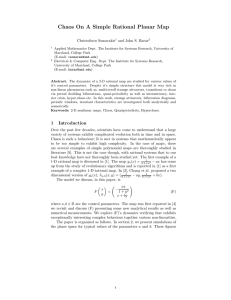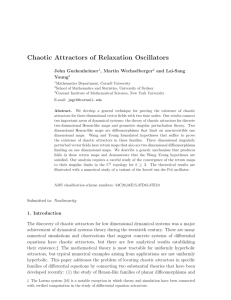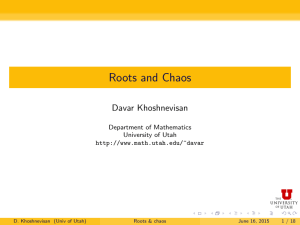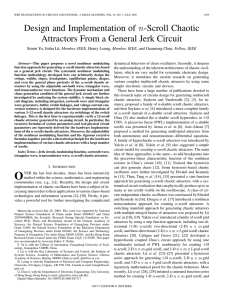Math 5470 - 1 Chaos Theory ... Math 6440 - 1 T, Th 9:10 -...
advertisement
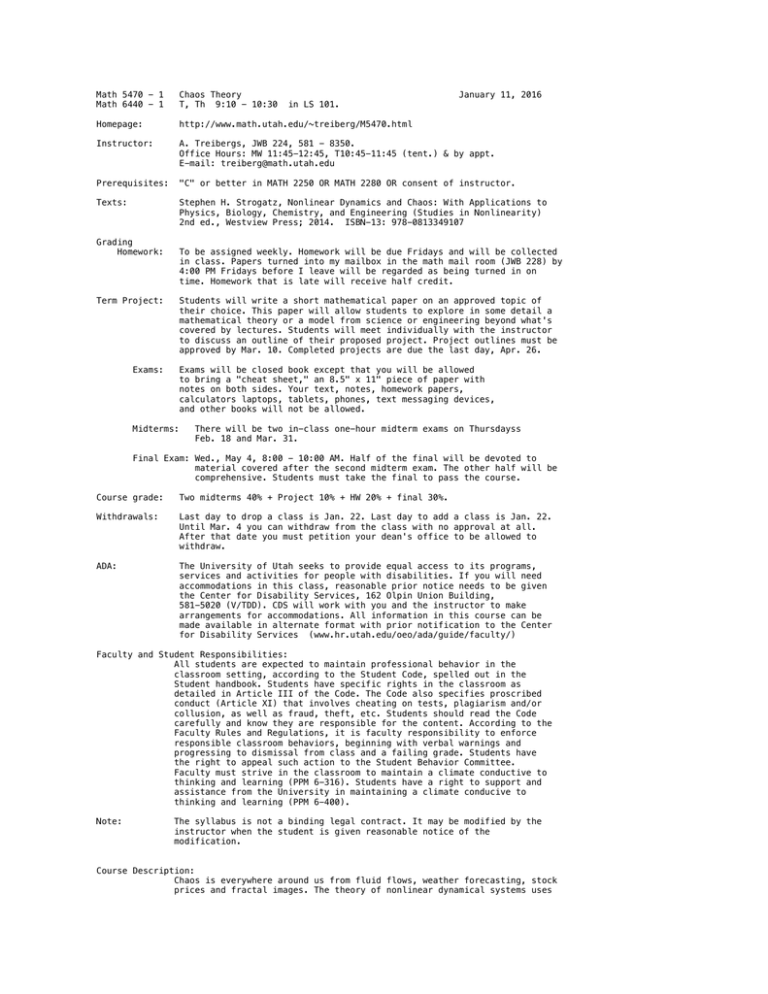
Math 5470 - 1 Math 6440 - 1 Chaos Theory T, Th 9:10 - 10:30 Homepage: http://www.math.utah.edu/~treiberg/M5470.html Instructor: A. Treibergs, JWB 224, 581 - 8350. Office Hours: MW 11:45-12:45, T10:45-11:45 (tent.) & by appt. E-mail: treiberg@math.utah.edu Prerequisites: "C" or better in MATH 2250 OR MATH 2280 OR consent of instructor. Texts: Stephen H. Strogatz, Nonlinear Dynamics and Chaos: With Applications to Physics, Biology, Chemistry, and Engineering (Studies in Nonlinearity) 2nd ed., Westview Press; 2014. ISBN-13: 978-0813349107 Grading Homework: in LS 101. January 11, 2016 To be assigned weekly. Homework will be due Fridays and will be collected in class. Papers turned into my mailbox in the math mail room (JWB 228) by 4:00 PM Fridays before I leave will be regarded as being turned in on time. Homework that is late will receive half credit. Term Project: Students will write a short mathematical paper on an approved topic of their choice. This paper will allow students to explore in some detail a mathematical theory or a model from science or engineering beyond what's covered by lectures. Students will meet individually with the instructor to discuss an outline of their proposed project. Project outlines must be approved by Mar. 10. Completed projects are due the last day, Apr. 26. Exams: Exams will be closed book except that you will be allowed to bring a "cheat sheet," an 8.5" x 11" piece of paper with notes on both sides. Your text, notes, homework papers, calculators laptops, tablets, phones, text messaging devices, and other books will not be allowed. Midterms: There will be two in-class one-hour midterm exams on Thursdayss Feb. 18 and Mar. 31. Final Exam: Wed., May 4, 8:00 - 10:00 AM. Half of the final will be devoted to material covered after the second midterm exam. The other half will be comprehensive. Students must take the final to pass the course. Course grade: Two midterms 40% + Project 10% + HW 20% + final 30%. Withdrawals: Last day to drop a class is Jan. 22. Last day to add a class is Jan. 22. Until Mar. 4 you can withdraw from the class with no approval at all. After that date you must petition your dean's office to be allowed to withdraw. ADA: The University of Utah seeks to provide equal access to its programs, services and activities for people with disabilities. If you will need accommodations in this class, reasonable prior notice needs to be given the Center for Disability Services, 162 Olpin Union Building, 581-5020 (V/TDD). CDS will work with you and the instructor to make arrangements for accommodations. All information in this course can be made available in alternate format with prior notification to the Center for Disability Services (www.hr.utah.edu/oeo/ada/guide/faculty/) Faculty and Student Responsibilities: All students are expected to maintain professional behavior in the classroom setting, according to the Student Code, spelled out in the Student handbook. Students have specific rights in the classroom as detailed in Article III of the Code. The Code also specifies proscribed conduct (Article XI) that involves cheating on tests, plagiarism and/or collusion, as well as fraud, theft, etc. Students should read the Code carefully and know they are responsible for the content. According to the Faculty Rules and Regulations, it is faculty responsibility to enforce responsible classroom behaviors, beginning with verbal warnings and progressing to dismissal from class and a failing grade. Students have the right to appeal such action to the Student Behavior Committee. Faculty must strive in the classroom to maintain a climate conductive to thinking and learning (PPM 6-316). Students have a right to support and assistance from the University in maintaining a climate conducive to thinking and learning (PPM 6-400). Note: The syllabus is not a binding legal contract. It may be modified by the instructor when the student is given reasonable notice of the modification. Course Description: Chaos is everywhere around us from fluid flows, weather forecasting, stock prices and fractal images. The theory of nonlinear dynamical systems uses bifurcations, attractors and fractals to describe the chaotic behavior in the real world. The course gives an introduction to chaotic motions, strange attractors, fractal geometry: We shall generally follow Strogatz' text. We will emphasize applications taken from various subjects like mathematical biology, engineering, geometry and physics. Occasionally we'll refer to other texts. Topics include (depending on time): Mechanical Vibrations Chemical Oscillators Superconducting Circuits Insect Outbreaks Genetic Control Systems Chaotic Water Wheel Noisy Communications
